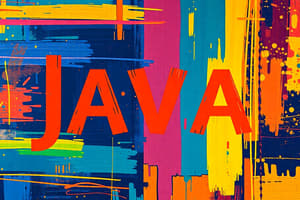Podcast
Questions and Answers
What does encapsulating data fields in a class help achieve?
What does encapsulating data fields in a class help achieve?
- Make classes easier to maintain (correct)
- Facilitate inheritance of properties
- Increase the uniqueness of objects
- Enhance the state of an object
When an object-oriented programming involves programming using objects, what does an object represent?
When an object-oriented programming involves programming using objects, what does an object represent?
- An entity in the real world that can be distinctly identified (correct)
- An entity without behaviors
- A static entity with fixed values
- A variable with primitive data type
How can you differentiate between instance and static variables and methods in Java?
How can you differentiate between instance and static variables and methods in Java?
- Static variables and methods belong to the class itself, while instance variables and methods belong to individual objects (correct)
- Static variables and methods can be accessed only within methods of the same class
- Instance variables and methods cannot be used outside the class
- Instance variables and methods are never accessed directly
What does creating immutable objects from immutable classes help protect?
What does creating immutable objects from immutable classes help protect?
How are variable scopes determined in the context of a class?
How are variable scopes determined in the context of a class?
Why is it important to define private data fields with appropriate get and set methods?
Why is it important to define private data fields with appropriate get and set methods?
Which of the following statements about the default constructor is true?
Which of the following statements about the default constructor is true?
When declaring object reference variables, how is the syntax typically structured?
When declaring object reference variables, how is the syntax typically structured?
How is the data of an object accessed in Java?
How is the data of an object accessed in Java?
What happens when you assign an object to a reference variable in Java?
What happens when you assign an object to a reference variable in Java?
Which statement accurately describes creating an object using a specified value?
Which statement accurately describes creating an object using a specified value?
In Java, how are non-static methods invoked on objects?
In Java, how are non-static methods invoked on objects?
What is the main difference between passing by value for primitive type value and passing by value for reference type value in Java?
What is the main difference between passing by value for primitive type value and passing by value for reference type value in Java?
In Java, what does an array of objects actually consist of?
In Java, what does an array of objects actually consist of?
When invoking a method that modifies an object's attribute in Java, how many levels of referencing are typically involved?
When invoking a method that modifies an object's attribute in Java, how many levels of referencing are typically involved?
What does 'n is 5' represent in the given code snippet?
What does 'n is 5' represent in the given code snippet?
When creating objects in Java, how are object references typically assigned?
When creating objects in Java, how are object references typically assigned?
What happens when you invoke circleArray.getArea() in Java?
What happens when you invoke circleArray.getArea() in Java?
Study Notes
Creating Objects Using Constructors
- A constructor is used to create an object, e.g.,
new Circle();ornew Circle(5.0); - A default constructor is automatically provided if no constructors are explicitly defined in the class
Declaring Object Reference Variables
- A reference variable is declared using the syntax
ClassName objectRefVar;, e.g.,Circle myCircle; - A reference variable is assigned an object using the syntax
ClassName objectRefVar = new ClassName();, e.g.,Circle myCircle = new Circle();
Accessing Object Members
- An object's data is accessed using
objectRefVar.data, e.g.,myCircle.radius - An object's method is invoked using
objectRefVar.methodName(arguments), e.g.,myCircle.getArea()
Passing Objects to Methods
- Passing an object to a method is called "passing by value"
- The value passed is the reference to the object
Array of Objects
- An array of objects is an array of reference variables, e.g.,
Circle[] circleArray = new Circle[ ]; - Each element in the array references a
Circleobject - Invoking a method on an element in the array involves two levels of referencing
OO Programming Concepts
- Object-oriented programming (OOP) involves programming using objects
- An object represents an entity in the real world that can be distinctly identified
- An object has a unique identity, state, and behaviors
- The state of an object consists of a set of data fields (also known as properties) with their current values
Studying That Suits You
Use AI to generate personalized quizzes and flashcards to suit your learning preferences.
Description
Learn how to create objects using constructors in Java, with examples such as creating a Circle object with or without parameters. Understand the concept of default constructors and how they are automatically provided when no constructors are explicitly defined in a class.




